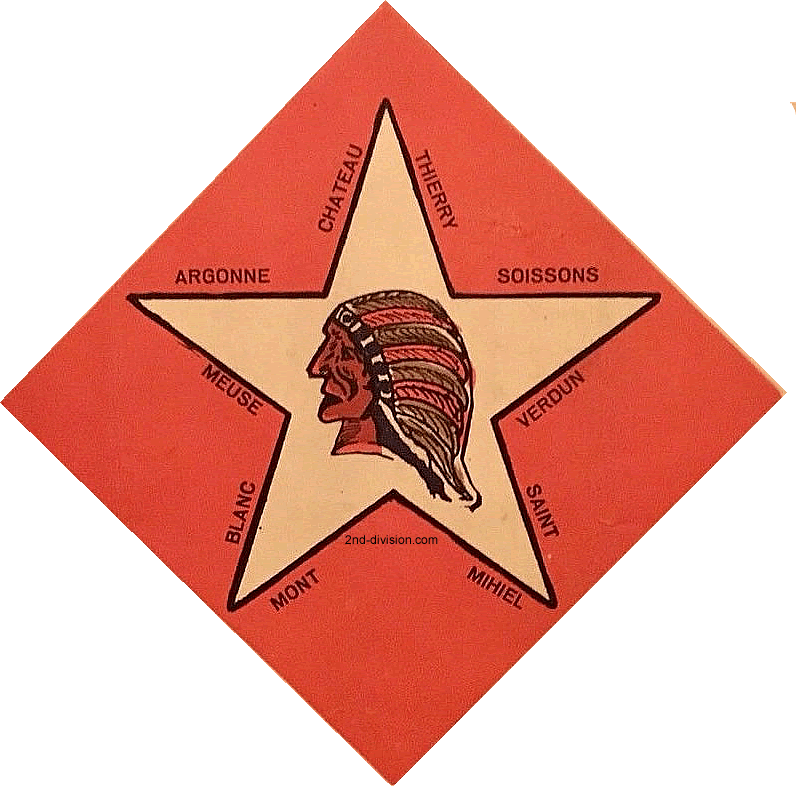|
TIME AND PLACE OF ORGANIZATION:
August 1st, 1917, Quantico, Va, (Hq, & Supply Cos.) |
 |
| |
SUB-DIVISIONS:
The composition of the battalions is as follows:-
1st Battalion — 74, 75, 76, 95.
2nd Battalion — 78, 79, 80, 96.
3rd Battalion — 82, 83, 84, 97.
73rd Machine Gun Co. |
| |
Names of Commanding Officers.
Colonel Albertus W. Catlin
(August 17th, 1917 — June 6th, 1918, when wounded in Belleau Woods).
Colonel Harry Lee (June 5th, 1918 — to date). |
| |
Date of Arrival in France.
October 5, 1917.
First battalion aboard USS Henderson arrived at St. Nazaire. |
| |
Training Periods.
November 17th, 1917 to January 15th, 1918, provost and construction duty throughout southen France; Bourmont training area January 15th — March 14th, intensive warfare training; vicinity of Vitry-le-Francois, May 12th, 1918. |
| |
Verdun Sector.
The regiment moved to the Toulon Sector, a few kilometers southeast of Verdun. The regiment remained in this quiet sector two months, part of which time the regiment and, during the rest of the stay, the division held a sector of its own. The men soon became accustomed to the enemy's shell-fire and gas, and by the middle of May considered themselves veteran soldiers. |
| |
Aisne-Marne Defensive (Chateau Thierry).
From May 20th — 30th the Regiment was billeted in the region north of Paris in and around the town of Serans, and on May 30th was rushed to Chateau Thierry front to help stop the Boche drive on Paris. The regiment went into positions in support of the French along a line extending from Le Thiolet through Triangle Farm, to Lucy-le-Bocage. The French were exhausted and dropped back of our lines. The Boche made several attempts to drive us back but failed. On June 6th Colonel Catlin was wounded and Lieut-Colonel Harry Lee assumed command of the regiment. After four weeks of almost continuous fighting this regiment was relieved by the 103rd Regiment of the 26th Division on the night of July 5th—6th and took up a position along the Army Reserve lines near Bezu-le-Guery. |
| |
Aisne-Marne Offensive (Soissons).
July 16th and 17th the regiment moved by camions to the Villers Cotterets forest south of Soissons. On July 18th Foch's great counter-attack started. This regiment was in division reserve in the initial attack, but the following day took over a three regiment front and advanced the line a kilometer and a half. |
| |
Marbache Sector.
Relieved July 19th, and went to the quiet Pont-à-Mousson Sector from August 7th to August 16th, when it moved to the Colombey-le-Belles area for training. |
| |
St. Mihiel Offensive.
On September 2nd the regiment started a series of night
marches which took it up to the jump-off positions for the St. Mihiel Offensive. The attack started at 5.00 A. M., September 12th. This regiment was in support of the 23rd Infantry. The troops jumped off from the trenches around Limey and advanced over ten kilometers, taking Thiaucourt and the heights beyond, capturing many prisoners, machine guns and cannon. On the following night the regiment relieved the 23rd Infantry and advanced to the Army Line, which it held until relieved on the night of September 15th-16th, by the 310th Regiment, 78th Division. Upon being relieved the regiment marched to the Foung area, remained there until September 27th, then moved by train to towns southeast of Chalons-sur-Marne. |
| |
Meuse-Argonne Offensive (Champagne).
Moved into trenches north of Somme-Py night of October 1—2. Advanced lines October 2nd preparatory to attack on Blanc Mont. Attacked on October 3rd, capturing Blanc Mont. Remained in line until night of October 9—10. Fighting was very heavy in this period. Upon relief marched to Chalons area. |
| |
Meuse-Argonne Offensive.
ON October 27th the Division was transferred to the First American Army, which was fighting in tho Argonne Forest. On the night of October 31st this regiment relieved a regiment of the 42nd Division in the front line near Sornmerance. The attack started at 5.30 on the morning of November 1st and was entirely successful. The enemy's line was broken, five towns were taken and many prisoners, machine guns and cannon were captured. On the night of November 2nd, the 3rd Brigade passed through the 4th Brigade and continued the advance to the Meuse. On the morning of November 11th, when hostilities ceased, this regiment was in support of the 23rd Infantry in the Bois-du-Fond d'Almon on the west bank of the Meuse. |
| |
March to the Rhine.
Beginning November 17th, as part of Column No.2, 2nd Division, took up a twenty-three day march through Belgium, Luxembourg and part of Germany to the Rhine. The route of march was as follows: Puilly — La Ferte — Arlon — Useldingen — Speldorf — Waxweiler — Prum — Hillesheim — Schuld — Ahrweiler — Sinzig and Brohl. Crossed the Rhine December 13th and three days later took over the left subsector of the Coblenz Bridgehead with Regimental Headquarters at Leutesdorf and battalions in Honningen, Rheinbrohl and Leutesdorf, Work was immediately started on the defence of the sector. |
|
|
|
|

